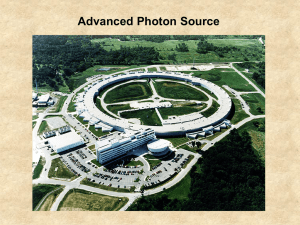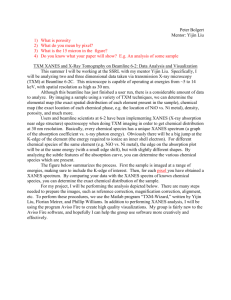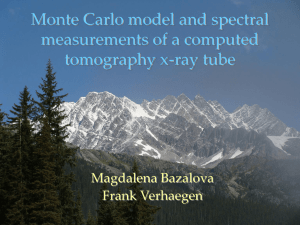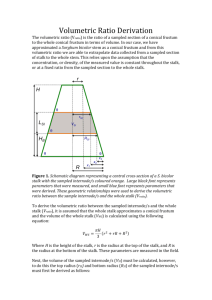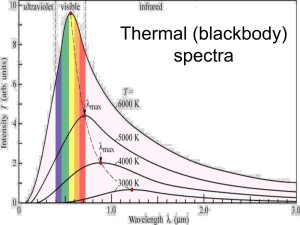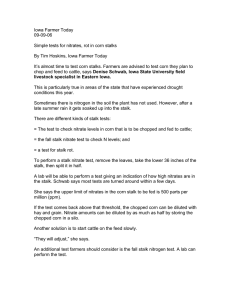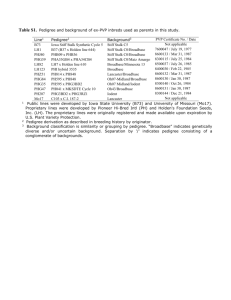Supplementary Methods (doc 38K)
advertisement
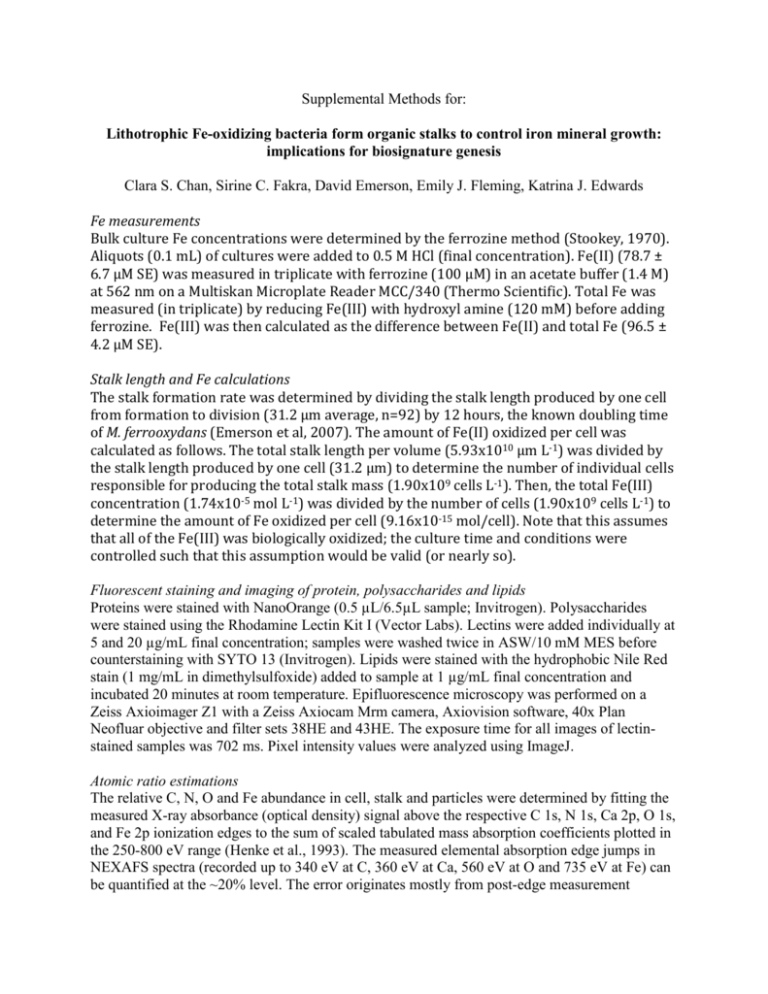
Supplemental Methods for: Lithotrophic Fe-oxidizing bacteria form organic stalks to control iron mineral growth: implications for biosignature genesis Clara S. Chan, Sirine C. Fakra, David Emerson, Emily J. Fleming, Katrina J. Edwards Fe measurements Bulk culture Fe concentrations were determined by the ferrozine method (Stookey, 1970). Aliquots (0.1 mL) of cultures were added to 0.5 M HCl (final concentration). Fe(II) (78.7 ± 6.7 µM SE) was measured in triplicate with ferrozine (100 µM) in an acetate buffer (1.4 M) at 562 nm on a Multiskan Microplate Reader MCC/340 (Thermo Scientific). Total Fe was measured (in triplicate) by reducing Fe(III) with hydroxyl amine (120 mM) before adding ferrozine. Fe(III) was then calculated as the difference between Fe(II) and total Fe (96.5 ± 4.2 µM SE). Stalk length and Fe calculations The stalk formation rate was determined by dividing the stalk length produced by one cell from formation to division (31.2 µm average, n=92) by 12 hours, the known doubling time of M. ferrooxydans (Emerson et al, 2007). The amount of Fe(II) oxidized per cell was calculated as follows. The total stalk length per volume (5.93x1010 µm L-1) was divided by the stalk length produced by one cell (31.2 µm) to determine the number of individual cells responsible for producing the total stalk mass (1.90x109 cells L-1). Then, the total Fe(III) concentration (1.74x10-5 mol L-1) was divided by the number of cells (1.90x109 cells L-1) to determine the amount of Fe oxidized per cell (9.16x10-15 mol/cell). Note that this assumes that all of the Fe(III) was biologically oxidized; the culture time and conditions were controlled such that this assumption would be valid (or nearly so). Fluorescent staining and imaging of protein, polysaccharides and lipids Proteins were stained with NanoOrange (0.5 µL/6.5µL sample; Invitrogen). Polysaccharides were stained using the Rhodamine Lectin Kit I (Vector Labs). Lectins were added individually at 5 and 20 µg/mL final concentration; samples were washed twice in ASW/10 mM MES before counterstaining with SYTO 13 (Invitrogen). Lipids were stained with the hydrophobic Nile Red stain (1 mg/mL in dimethylsulfoxide) added to sample at 1 µg/mL final concentration and incubated 20 minutes at room temperature. Epifluorescence microscopy was performed on a Zeiss Axioimager Z1 with a Zeiss Axiocam Mrm camera, Axiovision software, 40x Plan Neofluar objective and filter sets 38HE and 43HE. The exposure time for all images of lectinstained samples was 702 ms. Pixel intensity values were analyzed using ImageJ. Atomic ratio estimations The relative C, N, O and Fe abundance in cell, stalk and particles were determined by fitting the measured X-ray absorbance (optical density) signal above the respective C 1s, N 1s, Ca 2p, O 1s, and Fe 2p ionization edges to the sum of scaled tabulated mass absorption coefficients plotted in the 250-800 eV range (Henke et al., 1993). The measured elemental absorption edge jumps in NEXAFS spectra (recorded up to 340 eV at C, 360 eV at Ca, 560 eV at O and 735 eV at Fe) can be quantified at the ~20% level. The error originates mostly from post-edge measurement precision, with increasing error when the post-edge region recorded is too short. These elemental ratios are indicative and cannot be interpreted in terms of true atomic composition, due to 1) uncertainties in density of the chemical species present in the NEXAFS areas of interest, 2) assumption that the thickness times the density for each feature (cell, stalk, particles) is the same for the 5 different STXM regions analyzed (C, Ca, N, O, Fe) although care was taken to choose very similar morphologies, and 3) assumption that no other elements (such as S and P, which could not be measured) are present. Micro-focused X-ray absorption spectroscopy (µXAS) Micro-focused X-ray fluorescence (µXRF) mapping and micro X-ray absorption near edge structure (µXANES) spectroscopy were performed on beamline 10.3.2 of the Advanced Light Source (ALS) (Marcus et al, 2004) . Analyses were carried out on a culture sample grown on a silicon nitride window (Silson Ltd). A µXRF map of a twisted stalk (previously identified via STXM imaging) was acquired at 10 keV, with a beam size of 2 × 2 μm2, a pixel size of 1 x 1 μm2 and a counting time of 200 ms/pixel, using a seven-element Ge solid-state detector (Canberra). Fe 1s-edge µXANES spectra were collected (up to 300 eV above the edge) in fluorescence mode, on the stalk and surrounding particles. Spectra were calibrated using Fe foil first derivative set at 7110.75 eV (Kraft et al, 1996), deadtime corrected, pre-edge background subtracted, and post-edge normalized using standard procedures (Kelly et al. 2008). Leastsquares linear combination fitting (LCF) of the spectra was performed in the 7010-7410 eV range using a public Fe XAS database of well characterized Fe-bearing standards (Marcus et al. 2008) consisting of spectra recorded at ALS beamline 10.3.2, some from the public database of Newville et al. (1999) and some provided by other beamline users listed in the acknowledgements below. The reference spectra were acquired from over 70 minerals and glasses from 24 groups (metal, sulfide, carbide, olivine, orthopyroxene, clinopyroxene, silicate glass, phyllosilicate, amphibole, sulfate, carbonate, oxyhydroxides, and others). Full details on standard materials and their measurements can be found in Marcus et al. 2008 and Westphal et al. 2009. We performed LCF fitting by choosing the best fit from among ∼105 unique combinations of reference spectra taken three at a time, as previously described in Westphal et al. 2009. The best linear combination fit was obtained by minimizing the normalized sumsquares residuals [NSS = 100 × Σ(μexp – μfit )2/ Σ (μexp)2], where μ is the normalized absorbance. The error on the estimated percentages of species present using this procedure is estimated to ± 10%. All data processing and fitting were performed using a suite of custom LabView based programs available at the beamline. Henke B, Gullikson EM, Davis JC (1993). X-Ray interactions: Photoabsorption, scattering, transmission, and reflection at E = 50-30,000 eV, Z = 1-92. Atomic Data and Nuclear Data Tables 54: 181-342. Kraft S, Stümpel J, Kuetgens U (1996). High resolution X-ray absorption spectroscopy with absolute energy calibration for the determination of absorption edge energies. Rev Sci Instr 67: 681-687. Kelly S, Hesterberg D, Ravel B (2008). Analysis of soils and minerals using X-ray absorption spectroscopy. In: Ulery AL and Drees LR (eds). Methods of Soil Analysis, Part 5— Mineralogical Methods. Soil Science Society of America: Madison WI, pp 367-464. Marcus MA, MacDowell AA, Celestre R, Manceau A, Miller T, Padmore HA, Sublett R (2004). Beamline 10.3.2 at ALS: a hard X-ray microprobe for environmental and materials sciences. J. Synchrotron Radiat 11: 239-247. Marcus MA, Westphal A J, Fakra SC (2008). Classification of Fe-bearing species from K -edge XANES data using two-parameter correlation plots. J. Synchrotron Radiat 15: 463-468. Newville M, Carroll SA, O’Day PA, Waychunas G, Ebert, M (1999). A web-based library of XAFS data on model compounds. J. Synchrotron Radiat 6: 276–277. Westphal AJ, Fakra SC, Gainsforth Z, Marcus MA, Ogliore RC, Butterworth AL (2009). Mixing fraction of inner solar system material in comet 81P/Wild2. Astrophysical J 694: 18-28. Acknowledgements We gratefully acknowledge the use of reference spectra and/or samples from Deborah Bond, Thomas Borch, Benjamin Bostick, Tonio Buonassisi, Marc Burchell, Anna Butterworth, Scott Fendorf, Jacob Frommer, Colleen Hansel, Matthias Heuer, Anthony Kearsley, Christopher Kim, Matt Newville, Peter Nico, Peggy O'Day, Nelson Rivera, Kent Ross, Cara Santelli, Brandy Toner, Andreas Vogelin, Glenn Waychunas
